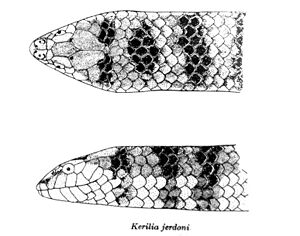Jerdon's sea snake facts for kids
Quick facts for kids Jerdon's sea snake |
|
|---|---|
 |
|
| Conservation status | |
| Scientific classification | |
| Genus: |
Hydrophis
|
| Species: |
jerdonii
|
| Synonyms | |
|
|
The Jerdon's sea snake (Hydrophis jerdonii) is a type of venomous sea snake. It belongs to a group of snakes called Hydrophiinae, which are all adapted to live in the ocean. This snake is known for its special patterns and how it moves in the water.
Contents
What's in a Name?
The second part of the snake's scientific name, jerdonii, is a tribute to a British zoologist. His name was Thomas C. Jerdon. Scientists often name new species after people they want to honor.
How to Spot Jerdon's Sea Snake
Jerdon's sea snake has a short head. Its snout, or nose area, is narrow at the front. The snake's eyes are of a normal size.
Scales and Body Features
The scales on the snake's neck are arranged in 17 rows. Around the middle of its body, there are usually 21 or 23 rows of scales. Sometimes there are 19 rows. These scales overlap each other and have a strong ridge, or keel, down the middle.
The scales on the snake's belly are called ventral scales. There are between 225 and 253 of these scales on snakes found near India and the Gulf of Siam. Snakes from other areas, like Cap St. Jacques, can have 247 to 278 ventral scales.
Color and Patterns
The top of Jerdon's sea snake is usually olive green. Its underside is yellowish or white. It often has black spots or diamond shapes along its back. In younger snakes, these spots can form complete black bands around the body.
Snakes from the Bay of Bengal usually have 19 or 21 scale rows at mid-body. They also have about 30 to 38 dark bars or bands on their back. Snakes from the Gulf of Siam typically have 21 or 23 scale rows at mid-body. They have about 34 dorsal bars.
Size of the Snake
A full-grown Jerdon's sea snake can be about 1 m (3.3 ft) long. Its tail is usually around 10 cm (3.9 in) long.
Where Jerdon's Sea Snake Lives
This sea snake can be found in many parts of the Indian Ocean. This includes the coasts of Bangladesh, Sri Lanka, India, and Myanmar (Burma). It also lives around the Mergui Archipelago.
You can also find it in the South China Sea and along the coast of Taiwan. It lives near the coasts of West Malaysia and in the Gulf of Thailand. It is also found in Indonesia, especially near Borneo.
A specific type, called siamensis, lives mainly in the Gulf of Thailand. The first Jerdon's sea snake ever officially described was found in Madras, India.


